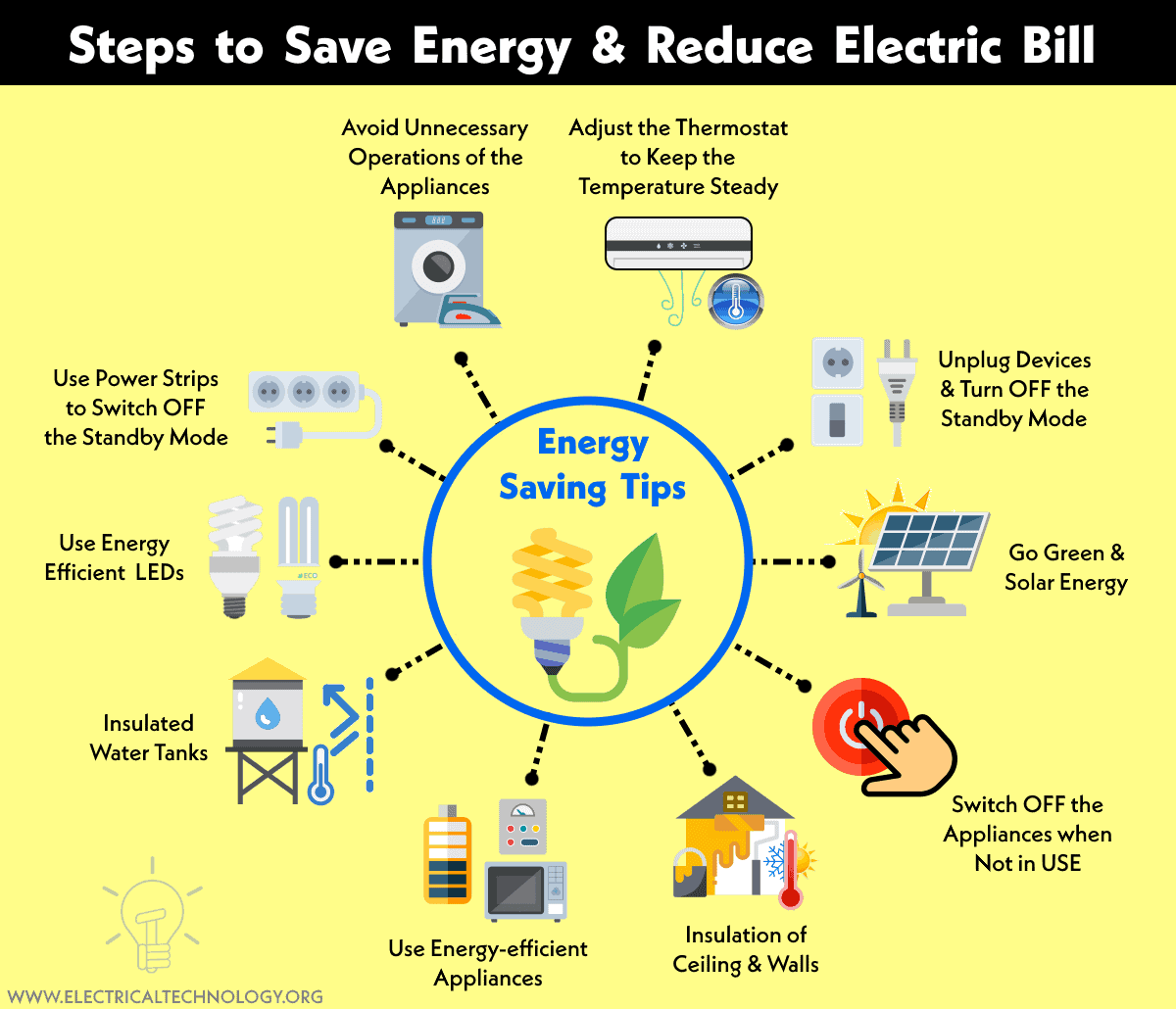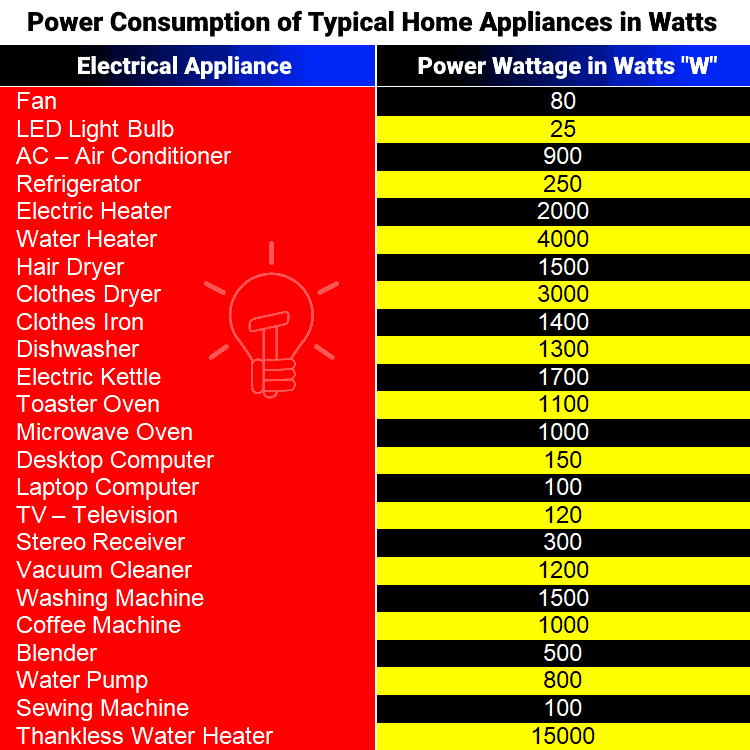How to Reduce Your Electric Power Bill? – 12 Steps to Save Electricity
12 Steps to Save Energy and Lower Your Electricity Bill
Electricity is a vital commodity in our daily lives. We use it for lighting, powering electronic devices, heating, and cooling our homes and offices, among other things. However, the cost of electricity has risen in recent years, and many people are looking for ways to reduce their electricity bills. In this article, we will provide you with steps on how to save electricity, energy and power consumption to reduce your electricity bill.
Click image to enlarge
1. Turn OFF Standby Mode (When Not in Use)
One of the most straightforward ways to save electricity is to turn off electrical and electronic devices and appliances when they are not in use. This includes turning off the lights when you leave a room, turning off the television when you are not watching it, and unplugging chargers when they are not charging anything.
Good to Know:
- For ease of use, you may consider the smart plug or standby saver to do the job to switch off all the appliances in single operation.
- Some appliances like satellite TV recorders need to be always plugged as it will reset the programing if unplugged unnecessarily
2. Switch OFF & Avoid Unnecessary Operations of the Appliances
As a matter of common sense, you should turn off lights and bulbs when leaving a room or when they are not in use. Similarly, you should avoid operating the dishwasher frequently, especially for washing one or two plates (or serving dishes and mugs etc.), unless it is full. The same goes for fridges, washing machines & laundries, kitchen appliances, showers, and bathrooms.
To save extra money, dry your clothes inside a rack or outside in open air and warmer weather (on sunny days when possible) instead of ironing or using a tumble dryer.
Good to Know: Avoid operating the high wattage appliances in the peak hours if applicable in your region by supply providers.
3. Use Power Strips
Power strips can help you save electricity by allowing you to turn off multiple electronic and electrical devices and appliances at once. This is particularly useful for electronics that consume electric power even when they are not in use, such as televisions and computers.
4. Replace Incandescent Light Bulbs with CFLs & LEDs
Incandescent light bulbs are inefficient and use more electricity than newer, energy-efficient light bulbs, such as compact fluorescent bulbs (CFLs) or light-emitting diodes (LEDs). Replace incandescent bulbs with CFLs or LEDs to save electricity and reduce your electricity bill.
For example, a 120 watts incandescent lamp = three 40 watts tube light = Ten Nos of 12 Watts LEDs bulbs will use the same power. This way, less number of LEDs lights (which save electricity) are required to illuminate the desired area.
5. Use Energy-efficient Appliances
Energy-efficient appliances use less electricity than older, less efficient models. When shopping for new appliances, look for those with an Energy Star label, which means that they meet specific energy efficiency standards set by the U.S. Environmental Protection Agency. For example, you may go for a DC inverter instead of Split Air-conditioner or Window type ACs.
6. Adjust the Thermostat
Heating and cooling our homes is one of the most significant expenses on our electricity bills. By adjusting the thermostat, you can save a significant amount of electricity. During the summer, set the thermostat to 78°F (26°C) or higher, and during the winter, set it to 68°F (20°C) or lower.
Similarly, you may follow the same process with electric water heaters etc.
7. Install a Programmable Thermostat
A programmable thermostat allows you to set the temperature in your home based on your schedule. This means that you can lower the temperature when you are away from home or sleeping and raise it when you are home and awake. This can save a significant amount of electricity and reduce your electricity bill.
8. Insulation of Water Tanks
Insulating hot water tanks and cylinders to a minimum standard of 2 inches high density insulation foam in the US (or a minimum of 50mm to 80mm thickness of spray foam insulation, according to the British Standard) is an effective way to reduce electric bill on an annual basis.
In addition, using a conical baffle in a geyser (water heater) may help to improve its efficiency and save on energy costs. The baffle helps to reduce heat loss by preventing hot water from rising directly to the top of the tank and mixing with the colder water near the surface. This can help to maintain the temperature of the water in the tank and reduce the amount of energy needed to heat it up again.
9. Insulation of Ceiling & Walls
Effective insulation and painting of old homes and premises, especially around outlets and shops, can have a big impact on your electricity bill. A well-furnished, renovated, and insulated roof, floor, and walls will reflect light properly throughout the entire area.
In addition, draughts in the building, open doors and windows, gaps around the walls, and cracks in the floors and chimney can cause a loss of heat, resulting in higher electricity bills for both cooling and heating, depending on the season. Therefore, proper draught-proofing is necessary to eliminate this issue which help to reduce the overall power and energy consumption.
10. Use Natural Light
Take advantage of natural light by opening blinds and curtains during the day. This will reduce the need to use artificial lighting and save electricity.
11: Improve the Power Factor
If you have a sufficient amount of inductive load, such as motors & transformers, improving the power factor can significantly reduce the overall electricity bill.
Power factor correction reduces the excessive amount of unwanted Volt-Amp Reactive (VAR) components, thereby providing leading Vars to stabilize the system and ensure smooth operation. It is important to note that poor power factor has several other disadvantages as well.
12. Switch to Green & Renewable Energy
Switching to green energy sources such as solar or wind power is a smart way to reduce your electric bill while also contributing to a cleaner and more sustainable environment. By using solar panels or wind turbines to generate electricity, you can greatly reduce your reliance on traditional power sources that rely on fossil fuels.
With renewable energy, you can produce your own energy and even sell any excess energy back to the grid. This means you can save money on your electricity bill while also making a positive impact on the planet. Investing in green energy may require an initial investment, but the long-term benefits are worth it. Not only will you save money on your bills, but you’ll also be doing your part to reduce greenhouse gas emissions and combat climate change. So, switch on green energy today and make a difference for the planet and your wallet.
As a reference, the following table shows the power consumption of typical home appliances and devices in Watts.
In conclusion, saving electricity is essential for both the environment and your wallet. By following these steps, you can reduce your electricity bill and do your part to conserve energy. Remember, every little bit helps, and even small changes can add up to significant savings over time.
Related Posts:
- How To Calculate Your Electricity Bill. Electric Bill Calculator with Examples
- Energy and Power Consumption Calculator – kWh Calculator
- Electric Energy Cost Calculator – Cost of Energy Calculation









Cool